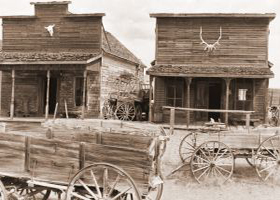


Yet his career was not launched aloft by religion, but by inflation – inflation during the deflationary years before the First World War. At the 1896 Democratic convention, he told the delegates:
Having behind us the commercial interests and the laboring interests and all the toiling masses, we shall answer their demands for a gold standard by saying to them, you shall not press down upon the brow of labor this crown of thorns. You shall not crucify mankind upon a cross of gold.
What makes this worthy of remark is former IMF chief economist Simon Johnson‘s remark, when comparing recessions from this century, the last one, and the one before:
“But experience at the end of the 19th century was also quite different from the 1930s – not as dramatic, yet very traumatic for many Americans. The heavily leveraged sector more than 100 years ago was not housing but rather agriculture – a different play on real estate.”
He discounts a 1930s Great Depression, but entertains the notion that the 19th century suggests parallels to current turmoils.
The main features of the Great Depression have not yet manifest themselves and still seem unlikely. But it is increasingly likely that we will find ourselves in the midst of something nearly as traumatic, a long slump of the kind seen with some regularity in the nineteenth century, particularly if presidential election-year politics continue to head in a dangerous direction. Downturns were not short and swift–the post-Second World War experience. They were long and protracted. He adumbrates three features of Great Depression: a drastic drop in output, swollen unemployment and bank credit that simply dried up – as banks themselves became just so many .
In the 19th century, it was different.
There were booming new technologies in that day, including the stories we know well around the rapid development of transportation, telephones, electricity, and steel. But falling agricultural prices kept getting in the way for many Americans. With large debt burdens, farmers were vulnerable to deflation (a lower price level in general or just for their products). And prior to the big migration into cities, farmers were a mainstay of consumption.
The solution then, Johnson notes, alluding to Byran, was inflation, as against the check on prices that gold seemed to have. Byran wanted bimetallism, with silver coined at a ratio of 16:1 to gold. Silver was found in profusion in the U.S. at the time, and thus its price was falling, relative to rather more scarce gold.
Interestingly, as gold hovers at $1700-$1800 an ounce (a far cry from the inflationary days of the 1990s, in which it had difficulty maintaining $250 an ounce) perma-bear Eric Sprott is selling some of his gold … for silver, which is now trading at 45 times the price of gold (instead of 16 times).
